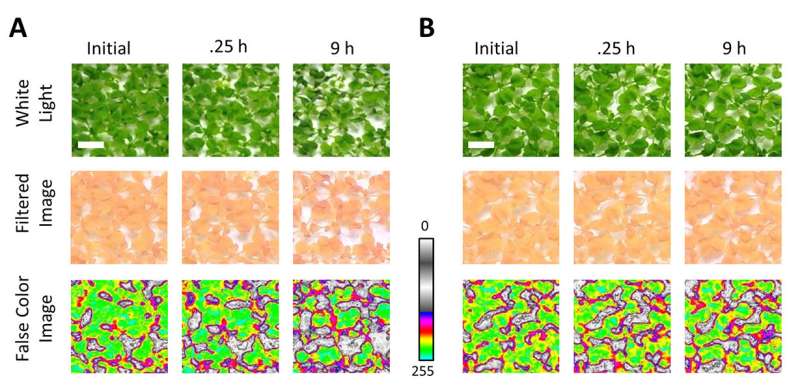A method to monitor indoor crop health no matter what planet you're on

As the world urbanizes and technologies such as LED grow lights bring down costs, indoor farming is becoming an increasingly important part of the food supply. Eventually, indoor farming techniques could help humans maintain a healthy diet in space. However, because of the completely closed systems in which indoor crops are grown, imbalances in soil nutrients, salinity, temperature, and other factors must be caught quickly to avoid losing a whole crop. In work published in a recent issue of Applications in Plant Sciences, Dr. Robert Ferl and colleagues at the University of Florida Space Plants Lab developed a light-based tool to assess plant health quickly, accurately, and inexpensively.
Not surprisingly for work coming from the Space Plants Lab, this study was conducted with an eye toward extraterrestrial farming. "Imagine a greenhouse being robotically maintained on Mars," said Dr. Ferl, corresponding author on the study. "The only data we can get back from that greenhouse is electronic. No sample return. Under those conditions it becomes really beneficial to derive as much data as possible from the photons that are coming off the leaves of plants." These photons make distinctive light signatures that can tell quite a bit about how a plant is doing, when analyzed using the normalized difference vegetation index (NDVI).
The NDVI is a widely used metric of plant health and photosynthetic rate that was originally developed for satellite-based monitoring of plant growth. This metric compares the plants' absorption of different spectra of light; healthy plants give off an identifiable light signature, absorbing light in the photosynthetically active region of light spectra, and reflecting near-infrared light. "[NDVI] proved to be an interesting starting point for the project simply because there is a large dataset and collective understanding that underpins the idea of using different spectral components to understand plant health," said Dr. Ferl. They adapted single-image NDVI (SI-NDVI), a low-cost version of this analysis, to see if it would be practical for monitoring crop health in indoor farming conditions.
Dr. Ferl and colleagues assessed the efficacy of this monitoring technique by exposing two different plants (arugula and the model plant Arabidopsis thaliana) to two different stressors (salinity and a high-concentration ammonium nitrate treatment) that create distinctive and well-understood stress responses. "Using these well-controlled stresses that have a well-defined biochemical basis for their responses is allowing us to probe the root causes of NDVI difference detections of stress or health responses," said Dr. Ferl. They were able to detect stress signatures from both treatments well before stress was visible to the naked eye, proving the utility of these techniques as early monitoring systems that can be deployed remotely and relatively inexpensively.
While these authors were primarily motivated by an interest in growing plants in space, the monitoring technique they developed could prove useful here on earth for indoor farmers looking to catch problems in the grow room quickly. "Single-image NDVI offers the opportunity to derive spectral character from a single RGB image. This keeps costs down," said Dr. Ferl. "It also opens the door to a large community of citizen scientists and applications developers that are interested in using SI-NDVI concepts commercially." This means that this method could be adapted to monitor a variety of crops grown under indoor conditions, which could mean less expensive, healthier salad greens on your table, whether that table be here or on Mars.
More information: Nicole S. Beisel et al, Utilization of single-image normalized difference vegetation index (SI-NDVI) for early plant stress detection, Applications in Plant Sciences (2018). DOI: 10.1002/aps3.1186
Journal information: Applications in Plant Sciences
Provided by Botanical Society of America





















